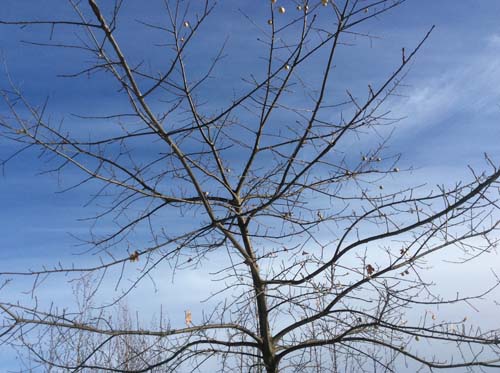Earth Notes: Oak apple day

By Alice Darlington
South Casco
One winter day, I was on my way home and stopped to eat my pizza slice and admire the view. Close by, I noticed a tree hung with tan balls almost as though decorated for the season. At first, I assumed it was a buttonbush but on looking more closely I saw that it was too tall for that and the balls too large. As I continued looking, I saw several dry oak leaves still hanging on. In addition, there were several smaller oaks nearby so I concluded the balls were oak galls, made by one of several species of wasp – why so many on this particular oak, I have no idea.
Oak galls are known as oak apple galls and are made by small wasps. The female gall wasp lays her single eggs in leaf buds and the larvae then feed on the tissue that develops around them because of the plant reacting to this invasion by increasing cell growth around the larvae — actually providing both home and larder to the growing invaders. Thus, protected and fed, the larvae then metamorphose into adults at which time they exit their galls through small holes. I have often found these dried up empty galls with their exit holes on the ground beneath oaks.
There are other kinds of oak galls such as the oak marble gall, oak artichoke gall and acorn cup gall each made by a different wasp.
Oak galls were used in the preparation of ink between the 5th and 19th centuries and is still sold today. The formulation is basically a solution of iron (for example from nails) and vinegar mixed with gallotannic acid usually extracted from oak galls. A well-prepared ink would gradually darken to purplish black that could not be erased by rubbing, only by scraping the layer off.
History, however, gives us a rather more romantic story that is commemorated to this day in England on May 29as Oak Apple Day or Royal Oak Day. After King Charles I lost his kingdom and eventually his head to Parliament’s armies led by Oliver Cromwell’s Puritans in the English Civil War, Charles’s son continued fighting until Cromwell defeated him at the battle of Worcester in 1651 whereupon he fled and, to escape capture, hid for a day in a large oak tree in Boscobel Wood. He then spent the next nine years in exile in Europe. Following the death of Cromwell, the monarchy was restored and Charles was invited to return to Britain, where he was received with great acclaim on his 30th birthday, May 29, 1660. The oak Charles hid in became much visited and its leaves and branches taken as souvenirs or to wear, eventually killing the tree. There is now a descendent of that tree, known as Son of Royal Oak, damaged in 1910, that is protected by a fence to protect both tree and present-day visitors.
Galls can be found on many other plants, caused by flies and wasps. I often see swellings on the stems of goldenrods that are caused by goldenrod gall flies, depositing their eggs in the stem or at the growing tip. These aren’t such safe places for the larvae as birds seem to recognize them and peck them open to eat the larvae. Perhaps, a safer place to deposit eggs is the dung beetle strategy of alighting on fresh dung and rolling a portion into a ball that the beetles then bury by excavating under the dung ball until it is buried and then laying the eggs in the ball that serves as cradle and larder for the larvae inside. Burying beetles, on the other hand, quickly locate a dead animal and excavate beneath it until it is beneath ground, cover it and then mate and lay their eggs in the carcass where the larvae feed and develop.
Parasitic wasps have many strategies for the survival of their offspring, one of which is to lay their eggs inside (sometimes also outside) a caterpillar, spider or other insect that then serves as fresh food for the wasp larvae.
So many strategies for survival in the long term that humans and other warm-blooded animals seem positively benign!

